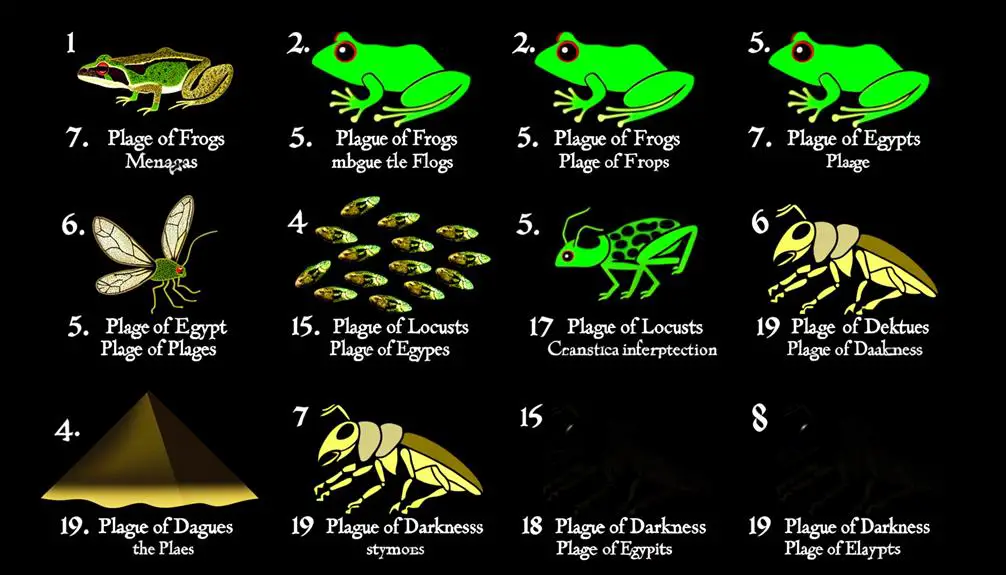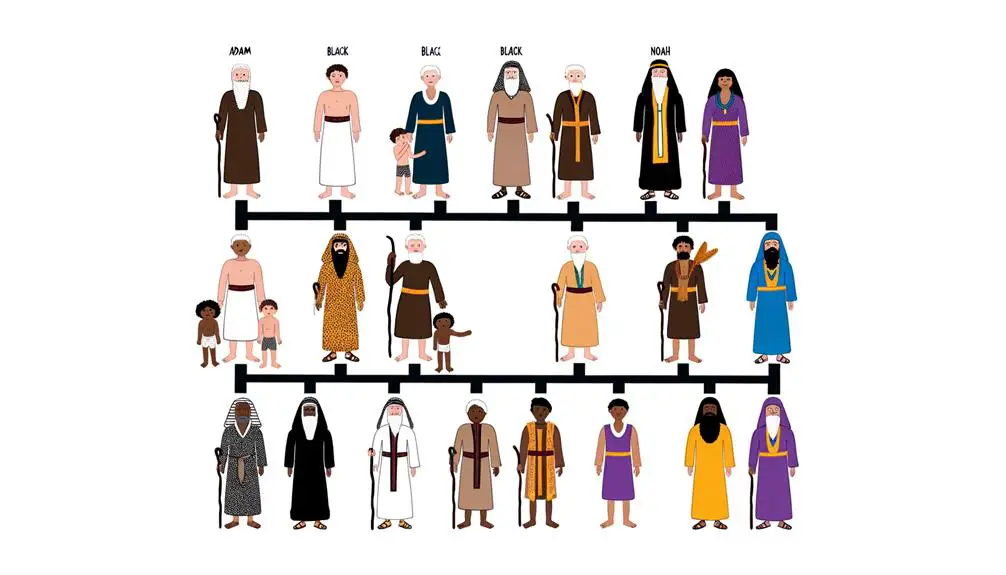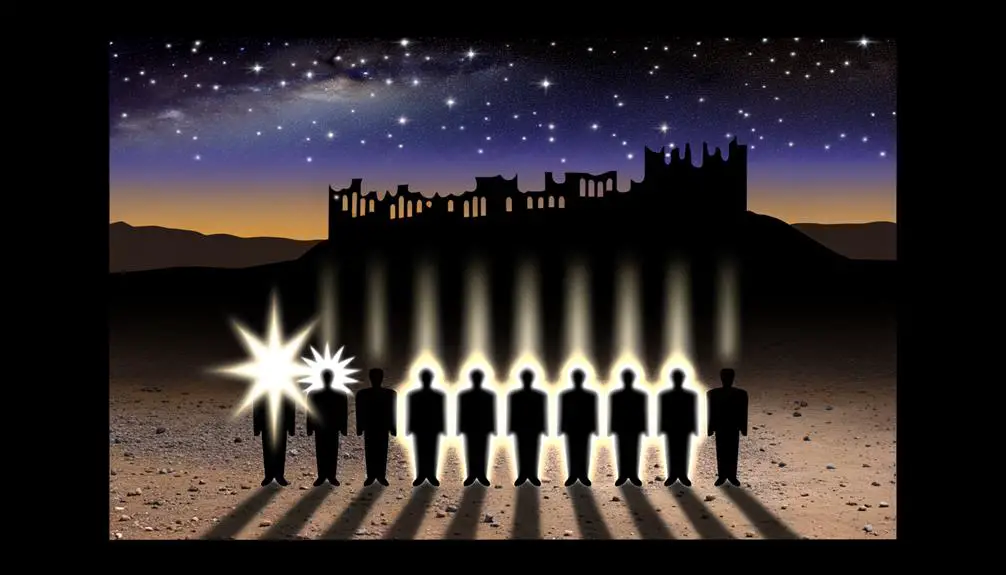Probe the profound significance of the number ten in biblical narratives, uncovering divine messages woven into ancient texts.

Number Ten in the Bible
In the Bible, ten signifies order, completion, and a divine reckoning. This is evident from the Ten Commandments that Moses received on Mount Sinai to the ten plagues that were a testament to Pharaoh's stubbornness. As you explore these instances, you'll notice a pattern that weaves through the fabric of biblical narratives, highlighting the significance of ten in both literal and symbolic forms.
You might find yourself asking, what deeper meanings could these occurrences hold, and how do they shape our understanding of biblical teachings? Let's embark on this journey together, unraveling the mysteries that the number ten holds within the sacred texts.
Key Takeaways
- The number ten symbolizes completeness, divine judgment, and testing in biblical narratives.
- Ten is foundational in practices like the Ten Commandments and tithing, influencing moral and ethical norms.
- Stories involving ten, such as the Ten Plagues and the Ten Virgins, carry deep symbolic and cultural interpretations.
- The repetition of ten across various contexts signifies its importance in understanding biblical teachings and divine principles.
The Ten Commandments

Central to the Judeo-Christian tradition, the Ten Commandments serve as foundational ethical directives that have profoundly influenced moral and legal norms throughout history. Delivered on stone tablets to Moses on Mount Sinai, these commandments aren't merely religious precepts but the moral foundation upon which much of Western law and ethics are built. You can perceive their influence in laws concerning murder, theft, and perjury, reflecting the enduring relevance of these ancient directives.
The inscription of the commandments on stone tablets symbolizes their permanence and unchangeability, suggesting that these principles are meant to endure through ages as the bedrock of moral guidance. This choice of material underscores the weight and seriousness with which they were to be regarded. You'll find that societies throughout history have grappled with the interpretation and application of these commandments, reflecting their central role in moral discourse and legal development.
Moreover, the Ten Commandments' role as a moral foundation can't be overstated. They encapsulate a comprehensive ethical system that goes beyond the legalistic, permeating aspects of personal integrity, social justice, and the relationship between individuals and the divine. This broad applicability ensures their relevance across different epochs and cultures, making them a cornerstone for ethical reflection and legal formulation.
In analyzing the Ten Commandments, it's clear that they represent more than historical artifacts. They're living documents that continue to shape moral and legal thought. Their inscription on stone tablets serves as a reminder of their enduring significance in guiding human behavior and fostering a just society.
Ten Plagues of Egypt

You'll find that the Ten Plagues of Egypt aren't only pivotal events in biblical narratives but also carry deep symbolic significance and historical context.
Each plague challenges the Egyptian gods, underscoring the power struggle between Pharaoh's authority and the divine will of the God of Israel.
Analyzing these events helps you understand their profound impact on cultural, religious, and historical perceptions.
Plague Significance
In examining the Ten Plagues of Egypt, one must consider their profound significance within biblical narratives, reflecting both divine judgment and the liberation of the Israelites. These events aren't only pivotal in the story of Exodus but have also shaped modern interpretations and cultural representations.
- Divine Judgment: The plagues are often seen as a direct response to Pharaoh's stubbornness, showcasing divine power.
- Liberation: They serve as a catalyst for the Israelites' freedom, highlighting themes of deliverance.
- Modern Interpretations: Scholars and theologians continue to explore the plagues' meanings, considering their moral and ethical implications.
- Cultural Representations: Art, literature, and film frequently reference the plagues, reflecting their enduring impact on collective imagination.
Analyzing these elements offers insights into their lasting significance.
Historical Context
To understand the Ten Plagues of Egypt, it's essential to delve into their historical context within ancient Egyptian society and the biblical narrative. These events, as recorded, are not merely historical occurrences but are imbued with deep numerical symbolism and cultural interpretations. The plagues challenged the Egyptian pantheon, directly confronting the gods' supposed powers and thereby underscoring the number ten's significance as a symbol of complete divine judgment and order restoration.
Plague |
Symbolism |
|---|---|
Water to Blood |
Challenge to the Nile's divinity |
Frogs |
Affront to fertility god Heqet |
Darkness |
Undermining sun god Ra |
This table illustrates how each plague targeted specific aspects of Egyptian life and belief, revealing the interplay between numerical symbolism and cultural interpretations within this historical event.
Tithing: A Ten Percent Offering

You'll find that tithing, a practice of giving ten percent of one's earnings, has a robust biblical foundation that influences its significance within religious contexts.
This tradition not only reflects a spiritual discipline but also profoundly affects believers' lives, shaping their financial and ethical outlook.
An analysis of its impact reveals the intricate relationship between faith, obedience, and personal growth.
Biblical Basis of Tithing
Tithing, a practice of offering ten percent of one's income, finds its biblical basis in numerous passages throughout both the Old and New Testaments. This tradition is examined through modern perspectives and charitable interpretations, highlighting its significance across eras.
- Genesis 14:20: Abraham's tithe to Melchizedek represents the earliest instance, setting a precedent for future generations.
- Leviticus 27:30-32: These verses codify tithing, specifying that a tenth of all produce and livestock belongs to the Lord.
- Malachi 3:10: This passage challenges believers to bring full tithes into the storehouse, promising blessings in return.
- Matthew 23:23: Jesus' affirmation of tithing, while emphasizing the importance of justice, mercy, and faithfulness, bridges the practice from Old to New Testament, ensuring its relevance.
Impact on Believers' Lives
Throughout history, believers have found that dedicating ten percent of their income as a tithe profoundly impacts their spiritual and financial lives. This practice, deeply rooted in numerical symbolism, serves as a tangible expression of faith and trust in divine provision. The act of tithing, a cornerstone among spiritual practices, fosters a sense of community and shared responsibility.
Aspect |
Impact |
|---|---|
Spiritual Growth |
Deepens faith and reliance on divine guidance. |
Financial Stewardship |
Encourages responsible and thoughtful financial planning. |
Community Support |
Strengthens communal bonds and mutual support systems. |
Trust in Divine Provision |
Reinforces belief in spiritual support for temporal needs. |
Numerical Symbolism |
Connects believers to biblical principles and teachings. |
This practice not only aligns with biblical teachings but also enriches the lives of individuals and communities, weaving a richer tapestry of spiritual connection and mutual care.
Ten Generations From Adam to Noah

In tracing the lineage from Adam to Noah, one finds a sequence of ten generations that encapsulates significant theological and historical implications within the biblical narrative. This progression highlights both the genealogical significance and the moral lineage that underpins much of the early scripture. The ten generations serve not only as a historical record but also as a moral compass, guiding the narrative from the innocence of the first man to the complexity and challenges faced by Noah and his generation.
The genealogical significance of these ten generations can't be overstated. They provide a clear lineage from the creation of man to the time of the flood, marking a critical period in the biblical account of humanity's early history. The moral lineage, on the other hand, offers insights into the evolving relationship between humanity and the divine, showcasing a gradual departure from divine laws and a movement towards moral ambiguity and eventual redemption.
- Genealogical Continuity: The ten generations from Adam to Noah ensure a continuous link, underscoring the importance of lineage in biblical narratives.
- Moral Lessons: Each generation encapsulates distinct moral lessons, reflecting the complexity of human nature and the consequences of straying from divine commandments.
- Theological Implications: The span of ten generations highlights significant theological themes, including sin, redemption, and the covenant between God and humanity.
- Historical Context: These generations provide valuable historical context, offering insights into the life and times of early biblical figures.
Ten Righteous People in Sodom

Although the narrative of Sodom and Gomorrah is often remembered for its destruction, a pivotal moment arises when Abraham intercedes with God, seeking to find ten righteous individuals to spare the city from judgment. This divine negotiation between Abraham and God showcases a profound exploration of the moral threshold required to avert disaster for the many, predicated on the righteousness of the few.
In this dialogue, Abraham questions God's justice, pondering whether it's right to destroy the righteous along with the wicked. He starts by asking if the city would be spared for fifty righteous people, then progressively lowers the number, finally asking if ten righteous individuals would suffice to save the city. This negotiation highlights the significance of the number ten as a symbol of collective righteousness sufficient to influence divine judgment.
The inability to find even ten righteous people in Sodom underscores the city's moral bankruptcy. It also reflects on the theme of collective responsibility and the impact of a righteous minority on the fate of a wider community. The narrative suggests that the presence of a small, morally upright group has the potential to counterbalance widespread wickedness and can be pivotal in the eyes of divine judgment.
This story raises critical questions about the moral fabric of societies and the role of individuals in upholding collective morality. The absence of ten righteous people in Sodom serves as a cautionary tale about the consequences of pervasive moral decay and highlights the importance of righteousness, even if it's found in a small number, in averting divine wrath.
The Parable of the Ten Virgins

Delving into the Parable of the Ten Virgins, we encounter a narrative that probes the virtues of preparedness and vigilance in the realm of spiritual readiness. This parable, found in the Christian New Testament, emphasizes the importance of being ready for the coming of the kingdom of heaven, likened to a wedding feast. The story contrasts ten virgins, five wise and five foolish, in their approach to wedding readiness, particularly focusing on their handling of lamp oil.
- Readiness for the Unexpected: The wise virgins bring extra oil for their lamps, anticipating delays. Their preparedness allows them to meet the bridegroom, symbolizing preparedness for the coming of Christ.
- Consequences of Unpreparedness: The foolish virgins, lacking sufficient oil, miss the opportunity to join the wedding feast when they leave to purchase more. This highlights the irreversible consequences of spiritual unpreparedness.
- Symbolism of Lamp Oil: Lamp oil serves as a metaphor for spiritual preparedness and the sustenance of faith over time. It emphasizes the need for personal responsibility in maintaining one's spiritual condition.
- Exclusion from the Kingdom: The most sobering aspect of the parable is the exclusion of the foolish virgins from the wedding feast, illustrating the finality of being unprepared at the time of Christ's coming.
Through this parable, the message is clear: vigilance and readiness are essential in the spiritual journey. The emphasis on wedding readiness and the careful management of lamp oil serves as a poignant reminder of the stakes involved in spiritual preparedness.
Ten Days of Tribulation

Exploring the 'Ten Days of Tribulation' reveals a period marked by intense testing and adversity, as referenced in the Book of Revelation, urging believers to steadfastness in their faith amidst challenges. This phrase, steeped in apocalyptic symbolism, serves as a metaphorical representation of trials and tribulations that the faithful endure, emphasizing the importance of perseverance and loyalty to one's beliefs.
The concept of 'Ten Days of Tribulation' isn't merely a literal timeframe but a symbolic duration that may represent a period of significant hardship. This interpretation aligns with the broader thematic elements of apocalyptic literature, where numbers often carry deeper meanings, symbolizing completeness, testing, and divine judgment. The number ten, in this context, underscores the idea of a complete cycle of testing, suggesting that believers must be prepared to endure trials until their faith is proven.
Endurance teachings are central to understanding the 'Ten Days of Tribulation'. These teachings encourage believers to maintain their faith and integrity, despite facing persecution or adversity. The narrative implies that enduring these trials is a testament to one's faithfulness and commitment to divine principles. It serves as a reminder that spiritual resilience and steadfastness are rewarded, reinforcing the idea that tribulations, though challenging, are temporary and serve a higher purpose in the spiritual refinement of the believer.
Frequently Asked Questions
How Does the Number Ten Symbolize Completeness in Biblical Numerology?
In biblical numerology, ten symbolizes completeness. This is evident in events and concepts like the Ten Plagues of Egypt, showcasing God's power and justice, and the Decalogue, or Ten Commandments, which outline moral and religious obligations.
These instances reflect the totality and perfection of God's plan. By examining these dimensions, you'll see how ten embodies a complete cycle or a divine order, reinforcing its significance throughout the scriptures.
Are There Instances Where the Number Ten Signifies a Trial or Test Outside the Commonly Discussed Biblical Stories?
You're exploring whether the number ten signifies trials or tests beyond well-known stories. Indeed, it does.
Consider the Ten Plagues, a series of calamities God inflicted upon Egypt to free the Israelites, showcasing judgment and testing Pharaoh's resolve.
Similarly, the concept of Ten Generations, spanning from Adam to Noah, illustrates a period of testing humanity's righteousness before the flood.
These instances highlight the thematic role of ten in symbolizing trials.
How Is the Number Ten Used in the Context of Blessings and Promises in the Bible?
In your inquiry, you're delving into how ten symbolizes blessings and promises, like a beacon illuminating paths in darkness.
The Ten Plagues, for instance, while initially seeming dire, ultimately led to the liberation of the Israelites, embodying a divine promise of freedom and redemption.
Similarly, Ten Generations from Adam to Noah highlight a long-term, unwavering commitment to humanity, despite its flaws, showcasing a pattern of trial followed by blessing and renewal.
In What Ways Does the Number Ten Represent Divine Order or Government in Scripture Outside the Ten Commandments?
You'll find that the number ten symbolizes divine order in scripture beyond the Ten Commandments.
For instance, the Ten Plagues of Egypt demonstrate God's authority over creation and judgment.
Similarly, the narrative of Ten Generations from Adam to Noah showcases a structured divine timeline leading to significant events.
These examples highlight how ten serves as a framework for understanding God's governance and intervention in the world, reflecting a pattern of divine order and purpose.
Can the Number Ten Be Linked to Any Prophetic Significance in the Bible Not Related to the Ten Days of Tribulation or the Ten Virgins?
You're exploring the prophetic significance of the number ten. Aside from the ten days of tribulation or the ten virgins, consider the Ten Plagues of Egypt and the Ten Generations from Adam to Noah. Both instances reflect a divine pattern of judgment and salvation, underlining the number's symbolic weight.
This analysis points to ten's broader role in biblical narratives, suggesting its importance in conveying themes of divine intervention and moral order.
Conclusion
In the tapestry of biblical narratives, the number ten emerges as a thread of divine order and judgment, weaving through stories of commandments, plagues, and parables. This numerical motif serves as an allegory for completeness and accountability in the spiritual journey.
From the foundational laws etched in stone to the ultimate test of faith and righteousness, ten symbolizes a cycle of trial, tribulation, and the eventual path to redemption. It invites reflection on the cyclical nature of human morality and divine grace.



Sign up